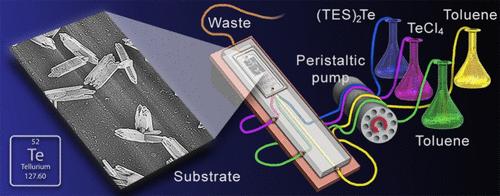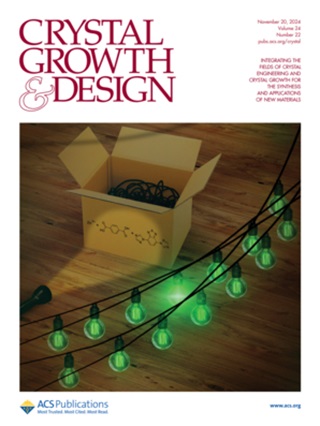溶液原子层沉积法室温合成碲
IF 3.4
2区 化学
Q2 CHEMISTRY, MULTIDISCIPLINARY
引用次数: 0
摘要
本研究展示了在常温下利用溶液原子层沉积 (sALD) 在硅/氮化硅基底上沉积碲 (Te)。该工艺采用四氯化碲(TeCl4)和双(三乙基硅基)-碲((TES)2Te)作为前驱体,甲苯作为溶剂。通过系统地改变脉冲和吹扫时间,对生长参数进行了优化。通过扫描和透射电子显微镜进行的形态表征显示出针状结晶,而 X 射线衍射仪则证实了沉积碲的结晶性质。增加沉积周期的次数可获得更大的碲晶体,并提高基底表面覆盖率。在晶体和碳夹杂物周围观察到一层薄薄的无定形碳壳,很可能来自有机溶剂。X 射线光发射光谱分析表明,碲薄膜纯度很高,表面氧化极少。较小的氯信号表明前驱体反应接近完全,副产物得到了有效净化。这种新型 sALD 方法为在温和条件下在各种表面沉积 Te 提供了一种可行的方法。本文章由计算机程序翻译,如有差异,请以英文原文为准。

Room Temperature Synthesis of Tellurium by Solution Atomic Layer Deposition
This study demonstrates the deposition of tellurium (Te) on silicon/silicon nitride substrates using solution atomic layer deposition (sALD) at ambient temperature. The process employs tellurium tetrachloride (TeCl4) and bis(triethylsilyl)-telluride ((TES)2Te) as precursors, with toluene as the solvent. Growth parameters were optimized through systematic variation of the pulse and purge times. Morphological characterization via scanning and transmission electron microscopy revealed needle-like crystallites, while X-ray diffractometry confirmed the crystalline nature of the deposited Te. Increasing the number of deposition cycles resulted in larger Te crystallites and enhanced substrate surface coverage. A thin amorphous carbon shell surrounding the crystallites and carbon inclusions was observed, likely originating from the organic solvent. X-ray photoemission spectroscopy analysis indicated high-purity Te films with minimal surface oxidation. The small chlorine signal suggested a near-complete precursor reaction and the efficient purging of byproducts. This novel sALD approach presents a promising method for depositing Te on various surfaces under mild conditions.
求助全文
通过发布文献求助,成功后即可免费获取论文全文。
去求助
来源期刊

Crystal Growth & Design
化学-材料科学:综合
CiteScore
6.30
自引率
10.50%
发文量
650
审稿时长
1.9 months
期刊介绍:
The aim of Crystal Growth & Design is to stimulate crossfertilization of knowledge among scientists and engineers working in the fields of crystal growth, crystal engineering, and the industrial application of crystalline materials.
Crystal Growth & Design publishes theoretical and experimental studies of the physical, chemical, and biological phenomena and processes related to the design, growth, and application of crystalline materials. Synergistic approaches originating from different disciplines and technologies and integrating the fields of crystal growth, crystal engineering, intermolecular interactions, and industrial application are encouraged.
 求助内容:
求助内容: 应助结果提醒方式:
应助结果提醒方式:


